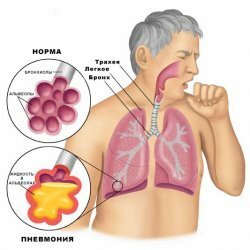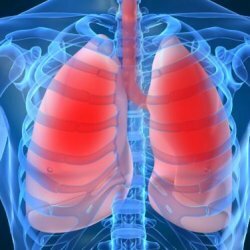Immunodeficiency and pneumonia
 Patients with immunodeficiency quite often are susceptible to the development of pneumonia, which is of particular importance and is topical for today, due to the constant increase in the incidence. It is difficult to diagnose pneumonia against the background of the main decrease in immunity and this is associated with a large lethality. It is not a secret that it is pneumonia that allows you to suspect an immunodeficiency in a person.
Patients with immunodeficiency quite often are susceptible to the development of pneumonia, which is of particular importance and is topical for today, due to the constant increase in the incidence. It is difficult to diagnose pneumonia against the background of the main decrease in immunity and this is associated with a large lethality. It is not a secret that it is pneumonia that allows you to suspect an immunodeficiency in a person.
In clinical development, pneumonia has typical symptoms, but due to the fact that many doctors are not wary of the fact that it can develop against the background of HIV, diagnose it and prescribe adequate treatment is not possible. People who have immunodeficiency, against which pneumonia develops, must first undergo a lot of examinations before they are diagnosed correctly. Meanwhile, the disease is exacerbated and harder to treat.
A person who has reduced immunity, in addition to diseases of the respiratory system caused by traditional pathogens, also get diseases that are not typical for people with normal immunity. Such a disease is called pneumocystic pneumonia, which develops only in patients with HIV status. The number of such patients totals in total, from 5.6 to 8.5% of those who are hospitalized with pneumonia and concomitant HIV or AIDS.
What contributes to the development of this type of pneumonia?
First of all, this is the degree and nature of the severity of the immune deficit. Factors that only contribute to the emergence and development of the disease can be called violations of cellular and humoral immunity. With any of the cellular options for reducing the immune system, there is a risk of developing pneumocystis pneumonia. When HIV is affected, T cells of the immune system that are unable to fulfill their basic purpose and are destroyed, but they can not adequately respond to getting into the organism of the pathogen. This is where the favorable environment for the development of pneumocysts is created.
Response to the development of pneumonia becomes a defect in the development of T cells, due to this the immune system can not cope with the disease itself and a person dies. The risk of developing this disease, as already mentioned, increases with a decrease in the cells of the immune system, a critical number of this decline is to call 200 cells per microliter.
Exit is
In order for PCP to minimize the threat to the body, it is worth taking a treatment that would promote the growth of cells of the immune system. Antiretroviral therapy copes with this. Along with this, do not forget about the decrease in other indicators of cellular immunity, but the physician will explain it in more detail.
The first suspicions of
The first doubts in the direction of pneumocystis pneumonia should be in the presence of HIV-positive status in humans and the development of several diseases that are specific for a condition with low immunity. Such diseases are called opportunistic and develop only in a weakened organism, the normal immune system constantly copes with them. It is extremely difficult to single out any precise diagnostic criteria, but the clinical symptomatology may push a doctor to the right idea, which then will be confirmed by some laboratory changes.
The first thing that will put an end to the diagnosis is pneumocysts isolated from the lungs. They are simply found under a microscope, since it is simply not possible to grow them on a nutrient medium. But medicine does not stand still, as does the diagnosis of diseases, and at the moment there are more accurate methods of diagnosis.
Such methods should be called, for example, the determination of RNA, a specific protein, which in a normal person who does not have infection, quickly disintegrates or does not exist at all, unlike the person with whom he is constantly present.
But to determine and see all the microorganisms, they should first be obtained and an important, albeit quite unpleasant procedure for bronchoscopy is used for this. It allows not only to take the material for analysis, but also to look at the bronchial condition and diagnose other diseases that can often develop against the background of a decrease in immunity. In the blood of changes that could give grounds for a correct diagnosis, there may also be no, only in the late stages of AIDS there can be changes.
There may be changes on the X-ray, but they may be absent, and in the meantime the process is actively developing. For the diagnosis of PCP pneumonia, X-rays are of low importance. At the initial stage of the disease, a normal x-ray picture is observed in a third of patients and only after a time changes develop.
Caution should not be a very bright start, which is typical for the classical version of the beginning and flow of pneumonia. The disease is more like a banal respiratory infection, develops weakness and fever, it can be accompanied by chills sometimes and increased sweating. The temperature in the beginning of the disease rises slightly, and its index is not so great. Next comes a cough that does not bring much relief, it lasts for weeks, and sometimes even months, becomes permanent and painful.
First of all there is shortness of breath, and it can be noticed in all patients, it grows over time and occurs only when the body is physically stressed. This should cause suspicion, especially at a young age. Respiratory insufficiency only grows and there are no changes on the x-ray or symptoms that could push the doctor. The only thing that can prompt it is the status of the patient, against which the clinic is developing.
You should not wait
At the first suspicions of pneumonia, and especially against the background of a decrease in the immune system, you should immediately consult a doctor. The earlier to begin treatment, both pneumonia itself and immunodeficiency, the more chances for a favorable outcome. It is important to remember that self-medication also will not lead to good and some drugs can be picked up correctly only by a specialist.



